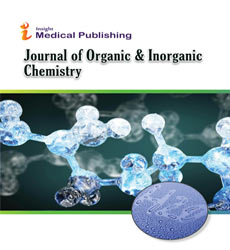Synthetic Strategies for Functionalized Organosilicon Compounds and Their Industrial Relevance
Hiroshi Tanaka
Department of Applied Chemistry, University of Tokyo, Tokyo, Japan
Published Date: 2025-02-28DOI10.36648/2472-1123.11.1.126
Received date: February 03, 2025, Manuscript No. ipjoic-25-20814; Editor assigned date: February 05, 2025, PreQC No. ipjoic-25-20814 (PQ); Reviewed date: February 17, 2025, QC No. ipjoic-25-20814; Revised date: February 22, 2025, Manuscript No. ipjoic-25-20814 (R); Published date: February 28, 2025, DOI: 10.36648/2472-1123.11.1.126
Citation: Tanaka H (2025) Synthetic Strategies for Functionalized Organosilicon Compounds and Their Industrial Relevance. J Org Inorg Chem Vol.11 No.1: 126.
Introduction
Organosilicon compounds represent a diverse and versatile class of materials with unique physicochemical properties arising from the incorporation of siliconâ??carbon bonds. Their stability, flexibility, and tunability have enabled widespread applications in pharmaceuticals, materials science, electronics, and coatings. Functionalized organosilicon derivatives, in particular, are at the forefront of innovation, as tailored modifications enhance reactivity and expand industrial applications. Understanding their synthetic strategies is therefore crucial for bridging fundamental chemistry with technological relevance. Siliconâ??s ability to form hypercoordinate species, its lower electronegativity compared to carbon, and its larger atomic radius impart distinct reactivity to organosilicon compounds. These features allow for stable yet flexible Siâ??C, Siâ??O, and Siâ??N bonds, making functionalized derivatives highly adaptable. Unlike purely organic frameworks, organosilicon systems exhibit resistance to thermal degradation and chemical oxidation, which enhances their industrial longevity [1].
Description
One of the most straightforward synthetic approaches involves the direct functionalization of silanes. Hydrosilylation, the addition of Siâ??H bonds across unsaturated substrates like alkenes and alkynes, is widely employed to generate functionalized organosilanes. Catalysts such as platinum, rhodium, and more recently, earth-abundant metals like iron and cobalt, have been utilized to improve selectivity and efficiency. Hydrosilylation is central to producing silicone polymers, adhesives, and surface-modified materials. Halosilanes serve as essential intermediates in organosilicon chemistry. Their synthesis through chlorination of silanes or silicon metals provides precursors for further functionalization via nucleophilic substitution. Alcohols, amines, and thiols readily react with halosilanes to form alkoxysilanes, aminosilanes, and thiolsilanes. These derivatives play key roles in solâ??gel chemistry, enabling the fabrication of silica-based nanomaterials and hybrid coatings [2].
Advances in cross-coupling chemistry have significantly expanded synthetic access to organosilicon compounds. Palladium- and nickel-catalyzed reactions between halosilanes and organometallic reagents facilitate the introduction of complex functional groups. Hiyama coupling, which employs organosilanes as coupling partners, is particularly notable for its mild conditions and tolerance of sensitive functional groups. Such methodologies are increasingly exploited in pharmaceutical synthesis, where organosilanes act as stable yet reactive intermediates [3].
Grignard and organolithium reagents provide another versatile route to organosilicon compounds. Their nucleophilic attack on halosilanes or alkoxysilanes enables the introduction of diverse alkyl and aryl substituents. This approach is particularly useful for synthesizing silicon-based monomers with tailored functionalities for polymer science. Despite challenges in controlling selectivity, recent advances in reagent design and reaction conditions have enhanced efficiency and broadened applicability. The solâ??gel process has emerged as a powerful method for preparing functionalized organosilicon materials. Alkoxysilanes undergo hydrolysis and condensation reactions to yield silica-based networks, which can be modified by introducing organic functionalities. This strategy enables the creation of hybrid organicâ??inorganic materials with tunable porosity, mechanical strength, and chemical resistance. Applications range from protective coatings and sensors to biomedical implants and drug delivery systems [2].
Functionalized organosilicon compounds serve as key building blocks in silicone polymers, elastomers, and resins. The incorporation of functional groups such as vinyl, epoxy, or amino moieties imparts improved adhesion, cross-linking ability, and thermal stability. These materials are indispensable in industries ranging from automotive and aerospace to electronics, where their flexibility, dielectric properties, and resistance to harsh environments are highly valued. Despite their promise, challenges remain in synthesizing organosilicon compounds [5].
Conclusion
Functionalized organosilicon compounds exemplify the synergy between synthetic innovation and industrial application. From hydrosilylation and cross-coupling strategies to solâ??gel chemistry, diverse methods enable their tailored design for sectors spanning materials science, energy, pharmaceuticals, and beyond. While challenges of selectivity, cost, and sustainability persist, continued research promises to unlock the full potential of organosilicon chemistry. Their unique properties and industrial versatility ensure that functionalized organosilicon compounds will remain pivotal to advancing modern science and technology.
Acknowledgement
None.
Conflict of Interest
None.
References
- Stangenberg R, Wu Y, Hedrich J, Kurzbach D, Wehner D, et al. (2015). A polyphenylene dendrimer drug transporter with precisely positioned amphiphilic surface patches. Adv Healthc Mater4: 377-384.
Google Scholar Cross Ref Indexed at
- Hammer BA, MuÃ?llen K. (2016). Dimensional evolution of polyphenylenes: Expanding in all directions. Chem Rev 116: 2103-2140.
Google Scholar Cross Ref Indexed at
- Hammer BA, Wu Y, Fischer S, Liu W, Weil T, et al. (2017). Controlling cellular uptake and toxicity of polyphenylene dendrimers by chemical functionalization. ChemBioChem18: 960-964.
Google Scholar Cross Ref Indexed at
- Yang J, Zhang Q, Chang H, Cheng Y. (2015). Surface-engineered dendrimers in gene delivery. Chem Rev115: 5274-5300.
Google Scholar Cross Ref Indexed at
- Carlmark A, Hawker C, Hult A, Malkoch, M. (2009). New methodologies in the construction of dendritic materials. Chem Soc Rev38: 352-362.
Open Access Journals
- Aquaculture & Veterinary Science
- Chemistry & Chemical Sciences
- Clinical Sciences
- Engineering
- General Science
- Genetics & Molecular Biology
- Health Care & Nursing
- Immunology & Microbiology
- Materials Science
- Mathematics & Physics
- Medical Sciences
- Neurology & Psychiatry
- Oncology & Cancer Science
- Pharmaceutical Sciences
